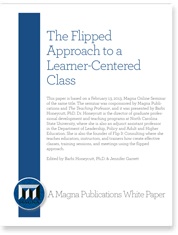We recently asked a group of teaching assistants, “How do you think today’s college classroom is different than when you were an undergraduate student? What is the most significant change you’ve noticed?”
Read more ›CURRENT ARTICLE • March 31
OTHER RECENT ARTICLES
“Students in inverted classrooms need to have more space to reflect on their learning activities so that they can make necessary connections to course content” (Strayer, 2012).
Read More › The following is an excerpt from the whitepaper “The Flipped Approach to a Learner-Centered Class.”
The following is an excerpt from the whitepaper “The Flipped Approach to a Learner-Centered Class.”
Blended learning entails more than simply replacing class time with online course elements or supplementing an online course with face-to-face meetings. To be successful, the online and face-to-face modes need to be integrated by taking into account the learning objectives and the affordances of each mode and deliberately linking what occurs in each mode.
Read More ›A survey conducted by the Center for Digital Education and Sonic Foundry found that 29 percent of faculty are currently using the flipped classroom model of instruction, with another 27 percent saying they plan to use it within the next 12 months.
Read More ›Nate Cottle, professor of human environmental sciences at the University of Central Oklahoma, uses the process approach to learning as delineated by William Horton (2006) in his online and blended courses. Cottle spoke to Online Classroom about using this model. “Learning isn’t something that has to be confined to the classroom, and so as I teach blended classes, I think the more I can involve the students in learning and the more contexts I can involve them in, the more they’re going to learn,” he said. “The idea is to get them to slowly digest the information in different ways and to engage in different activities so that by the time the course comes to an end, they can apply the knowledge they have learned. That’s the ultimate goal: to get them to be in a state where they can apply the knowledge.”
Read More ›It seems like everyone is talking about the flipped classroom. But how do you use this new model to construct lessons and assessments that reinforce student learning?
Read More ›A small but growing number of faculty at major universities are experimenting with the inverted or flipped classroom. It’s an instructional model popularized by, among other influences, a Ted Talk by Khan Academy founder Salman Khan, which has received more than 2.5 million views. Institutions as varied as Duke University’s School of Medicine, Boston University’s College of Engineering, and the University of Washington School of Business have joined Clemson, Michigan State, the University of Texas, and many others in experimenting with changing from in-class lectures to video lectures and using class time to explore the challenging and more difficult aspects of course content.
Read More ›Editor’s Note: The following is an excerpt from Ten Strategies to Improve Blended Course Design.
Read More ›The Internet flipped learning before instructors did. Want to find out something? Google it. Wikipedia it. Use your laptop or smartphone or iPad. That’s where the “answers” are. Some of us initially reacted to this cyber-democratization of information asserting, “This isn’t right! The Internet is full of incomplete and simply wrong information.” But the challenge to the classroom was more profound. It has raised questions among students and even administrators about the need for face-to-face classrooms at all, as if correct information and unchallenged “opinions” were all that was needed.
Read More ›




